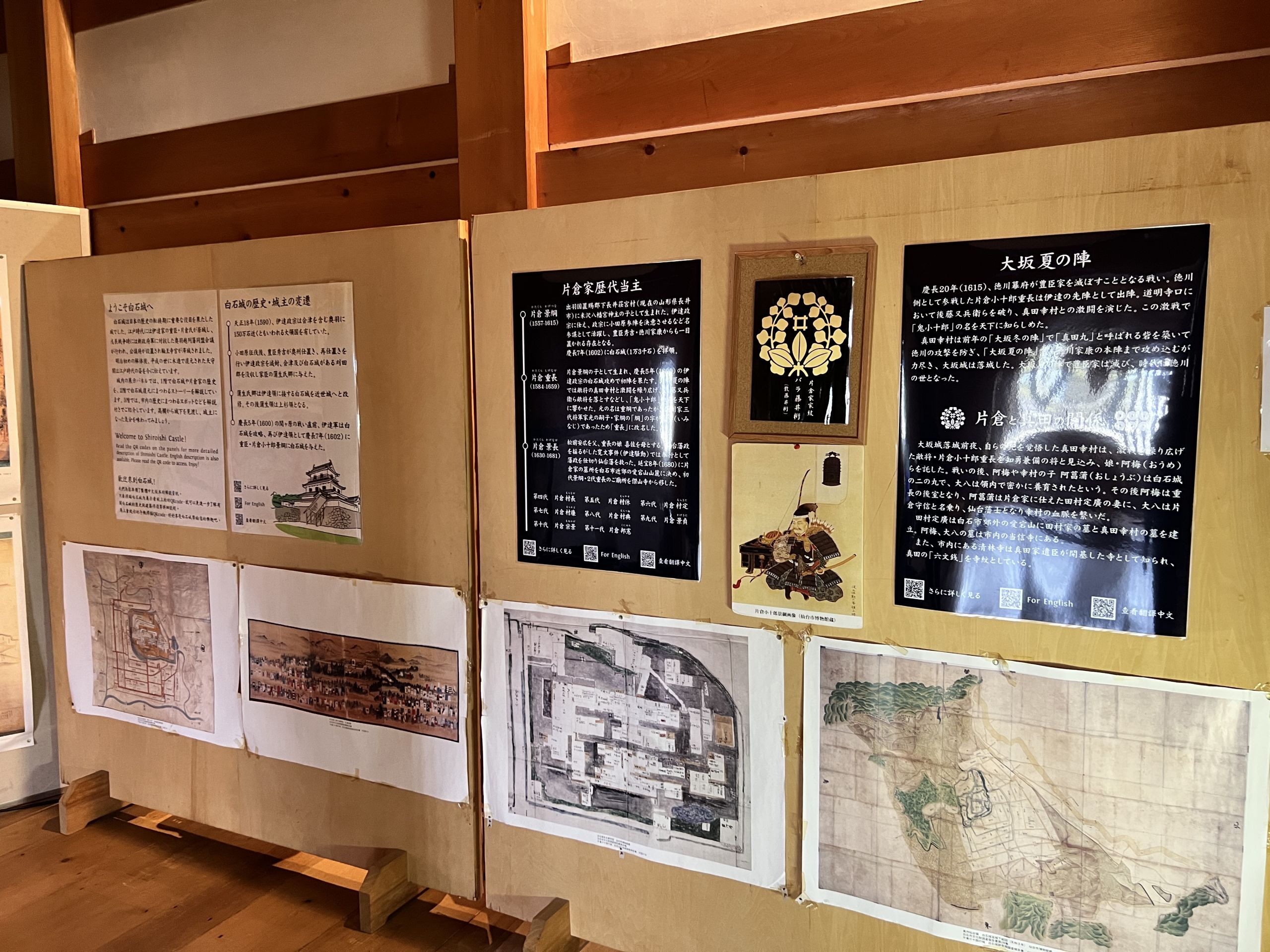History and Transition of the Lord of Shiroishi Castle
Shiroishi Castle played a significant role at a turning point in Japanese history. During the Edo period, the Katakura clan, a chief vassal of the Date family of Sendai, resided in the castle and governed Shiroishi City for 260 years as an entrance gate to the Sendai Domain. During the Boshin War (learn more about it below), the meeting of the Ouetsu-Reppan alliance was held to oppose the new government forces, and the parliamentary office was established to house the leader of the alliance, Rinnojinomiya. After the castle was demolished in 1874, the castle tower was reconstructed only with wood in 1995, showing how it looked in the Edo era. You can learn about the history of Shiroishi Castle and the Katakura family on the first floor, and the story behind the restoration of Shiroishi Castle on the second floor. On the third floor, you can enjoy the view of Shiroishi just like the Katakura family did, while reading descriptions about the historical sites in the city.
Transition of the Lord of Shiroishi Castle
Katta County, where Shiroishi Castle was located, was under the control of the Date clan in the late 16th century. In 1589, Date Masamune won a battle against the Ashina clan of the Aizu Domain and expanded its territory. He ultimately had a very large domain of nearly 1.5 million koku (currency at the time which was measured by rice yield) in the Tohoku region, including Aizu.
In 1590, the forces of Date Masamune were slow to participate in the Siege of Odawara. As a result, after the Siege of Odawara, Toyotomi Hideyoshi brought the whole country under one rule. When Toyotomi reorganized the territory map of Japan, he reduced Date Masamune's territory and confiscated Aizu and Katta County, where Shiroishi Castle was located and gave it to his vassal Gamo Ujisato. Gamo Ujisato was originally from Omi and built many castles and castle towns wherever he was assigned. Matsusaka City and Matsusaka Castle and Aizu Wakamatsu city and Aizu Wakamatsu Castle are some famous examples.
Gamo Ujisato renovated Shiroishi Castle into a modern castle. The castle was intended to suppress Date Masamune, as it bordered Date territory on the north side. Gamo's vassal, Gamo Genzaemon Satonari, was assigned as the lord of Shiroishi Castle. Later, the Gamo domain became the Uesugi domain, and Uesugi Kagekatsu's vassal, Amakasu Bingo Kiyonaga, settled in the castle.
Just before the Battle of Sekigahara, the forces of Date Masamune and the forces of Katakura attacked Shiroishi Castle, where the Amakasu clan had been residing. Masamune took advantage of the absence of Amakasu and built a base on a hill on the north side of Shiroishi Castle. Katakura's force built a base on the west. This operation was the first time for Katakura Shigenaga to participate in a battle, and he made a spectacular debut with heroic acts such as successfully invading the main castle. After Date Masamune's side won this battle, Tokugawa Ieyasu gave him Katta County and Shiroishi Castle. Just like the battle of Sekigahara, this battle was very crucial in the turning point of Japanese history. From the third floor of the castle tower, you can see the hill where Masamune built his force's base.
After this battle, the castle was then entrusted to Ishikawa Akimitsu, uncle of Date Masamune. However, in 1602, Shiroishi Castle was given to Masamune’s chief vassal, Katakura Kojuro Kagetsuna, and for the next 260 years, the Katakura clan held the castle. Located on the southern edge of Date's territory, this castle was an important base for Masamune to protect the southern side of his territory.
Shiroishi Castle and Ouetsu-Reppan Alliance
After the Tokugawa Shogunate was overthrown, the Boshin War was fought between the new government forces and the old shogunate forces. The Aizu domain, which had been strictly controlling the Satchō forces and other forces attempting to overthrow the shogunate as the protector of Kyoto, was declared an “enemy of the imperial court," and orders were issued to the Sendai, Yonezawa, and other domains to pursue the Aizu domain. In 1868, fourteen domains in Tohoku gathered and held "Shiroishi Conference” in Shiroishi Castle. Shiroishi Castle was a perfect meeting spot because it is located between Sendai and Yonezawa. As a result, a petition requesting relief for the Aizu domain was submitted to the pacification governor-general of the Tohoku region on the side of the new government, but it was rejected. Furthermore, the conflict became apparent when members of Sendai Domain assassinated Sera Shuzo, a member of the governor-general's office in Fukushima.
Later, Ouetsu-Reppan alliance was formed, and the parliamentary office was established to house the leader of the alliance, Rinnojinomiya in Shiroishi Castle. However, the domains in the alliance were defeated in the Boshin War, and Shiroishi was separated from the Sendai domain, and the Nanbu family, which had been governing the Nanbu domain, became the governor of the Shiroishi domain. In 1869, Shiroishi Castle was handed over to the Nanbu family, but the Nanbu family returned to Morioka. Katakura family and their vassals emigrated to Hokkaido after losing their place in SHiroishi. In 1874, Shiroishi Castle was dismantled.
Reference
・読売新聞東北総局, 1995, ""白石城物語""
・ Kenji Agatsuma et al, 1995, ”よみがえる白石城”

